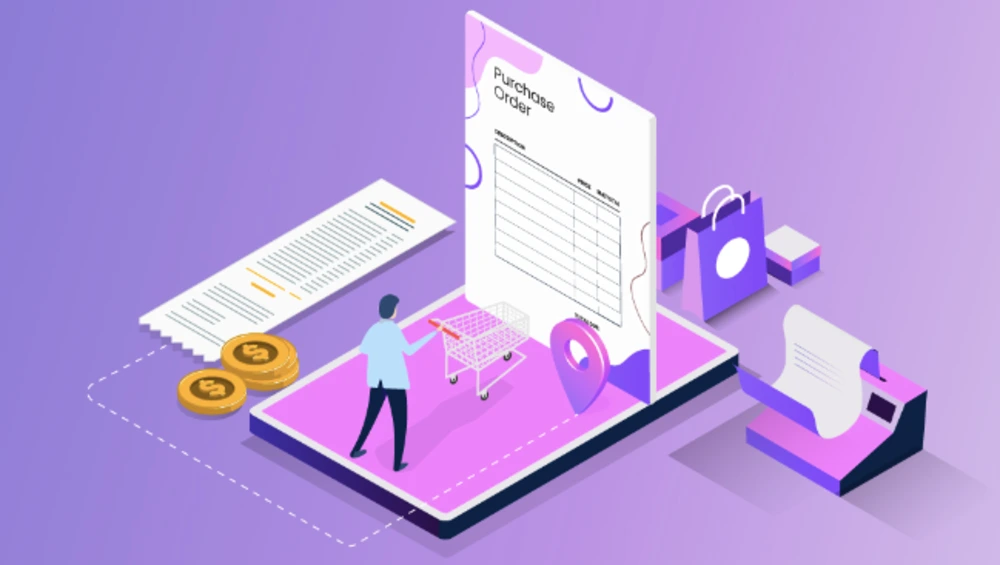
2024’s Game-Changer: Maximizing Efficiency with Purchase Approval Software
Managing purchases well is crucial, especially for medium and large companies. These businesses handle many transactions, each with its challenges. They must keep spending under control and ensure their operations run smoothly. The solution? is a robust and effective purchase approval system. Modern purchase approval software offers a straightforward and intelligent way to manage business purchases.
What is Purchase Approval Software?
Purchase approval software is a digital tool that helps organize and improve the purchasing process in a company. Its main jobs are automating the process of approving purchases, keeping track of spending, and ensuring purchases follow company rules.
This software makes the purchase order process simpler and more transparent, which is very important for businesses today.
How Purchase Approval Systems Have Changed?

Years ago, businesses would handle purchase orders manually with lots of paperwork. This old way could have been faster and often led to mistakes. But now, things have changed a lot.
With digital technology, purchase approval systems have become automated and more advanced. Modern software can track purchases in real-time, manage the approval process digitally, and work well with other business tools. This change means businesses can now handle purchasing more quickly, accurately, and reliably.
In short, the development of purchase approval systems reflects the overall shift in business towards being more efficient, precise, and insightful, thanks to digital technology.
Key Features of Effective Purchase Approval Software
When you’re in the market for purchase approval software, there are a few key features you should keep an eye out for. These features are crucial because they make the software more efficient and easier to use.
- Automation: This is a big one. Automation in purchase approval software means the system handles repetitive tasks for you. It’s like having an intelligent assistant who handles the routine stuff, like sending out approval requests and tracking responses. This saves time and cuts down on the chances of human error.
- User-Friendly Interface: You want to spend less time figuring out how to use the software, right? A user-friendly interface is essential. It means the software is easy to understand and navigate, even for someone who’s not a tech expert. This ease of use is vital because it means your team will use the software rather than avoid it.
- Integration Capabilities: The software should play well with others. By this, it should easily connect with other systems and tools you already use, like your accounting software. This integration is key because it helps streamline your purchasing process, making everything more efficient and connected.
The Benefits of Implementing Purchase Approval Software
Financial Control and Budgeting
Purchase approval software helps businesses manage their money better. It gives a clear view of spending and helps keep budgets on track. This tool helps leaders make smart spending decisions by showing them where their money is going.
Quick Approval Workflows
This software makes the approval process for purchases faster and more organized. It can be set up to fit how your business works, making sure that buying requests are checked and approved quickly. This keeps things running smoothly and avoids delays.
Easy Purchasing with Digital Catalogs

Digital catalogs in the software make it easier to choose and buy products. They list approved vendors and products, helping buyers make choices that fit company rules and quality standards. This speeds up buying and helps get good deals.
Customizable Approval Processes
The software can be adjusted to fit your company’s specific needs, whether that’s different levels of approval or rules for different departments. This makes sure the approval process works well with your company’s way of doing things.
Managing Purchase Orders Online
Switching to online management of purchase orders makes things more efficient. It cuts down on paperwork and makes it easier to create, change, and track orders. This saves time and reduces mistakes.
Tracking Orders in One Place
The software lets you see all your orders in one spot, which helps with managing spending. It makes it easier to see how much is being spent and where, which is useful for budgeting and finding ways to save money.
Tracking Shipments Clearly
The software includes shipment tracking, which lets you see where your orders are from the time they’re bought until they’re delivered. This keeps things transparent and helps everyone stay informed about their orders.
Simplifying Receipts and Confirmations
Automating the handling of receipts and delivery confirmations makes the buying process smoother. It saves time and reduces the chance of mistakes. This means goods and services are recorded quickly and accurately.
Working Well with Accounting Software
One of the key features of this software is that it can easily connect with existing accounting systems. This creates a single system for managing financial information, making it easier to handle and more accurate. It helps with reporting and gives a complete view of the company’s finances.
Making Better Business Decisions with Purchase Approval Software

Speeding Up Decision-Making
Purchase approval software makes decision-making in businesses faster and more informed. It gives managers and executives clear, data-based insights, helping them make decisions quickly and confidently. The software speeds up the process of approving purchases, cutting down the time needed for manual checks.
This leads to quicker decisions about spending and investing, improving how resources are managed. Faster decision-making helps increase productivity and allows businesses to act quickly on opportunities and solve problems before they grow.
Understanding Spending with Data Analytics
Data analytics is a crucial part of purchase approval software. It changes how businesses manage money by providing up-to-date reports and detailed spending analyses. This feature helps businesses see where their money is going and how it’s being used.
With this information, they can spot spending trends, find areas to cut costs and see the effects of their financial decisions. This knowledge lets businesses fine-tune their spending, get better deals, and use their resources more wisely. Access to current spending data helps businesses stay on top of their financial planning and make more intelligent, more strategic decisions.
Picking the Right Software
Choosing the best purchase approval software requires considering a few crucial points. Start by thinking about your business size. Small businesses usually need something simple and easy to use, while larger companies might want more advanced features, like the ability to work well with other systems and lots of customization.
The type of business you run matters, too. Different industries need different things. For example, a manufacturing business might want software that works well with its supply chain, but a company focused on services might be more interested in handling invoices and keeping track of budgets.
It’s also important to find software that fits how your business works. It should match your current processes and be flexible enough to change as your business does. Look for features like setting up different levels of approval, controlling who can do what, and handling different kinds of purchase orders.
Consider how easy the software is to use and the kind of help the company offers. Your team will more quickly accept software that’s easy to use. Good customer support is also key for solving problems and getting the most out of the software. The right software should meet your needs now and be able to grow with your business.
Questions to Ask Vendors

When considering purchase approval software, it’s crucial to engage with vendors to understand how their solutions can best fit your business needs. Here are some key questions to ask:
Can the software be customized to fit our specific business processes?
Inquire about the flexibility of the software in terms of customization. This includes adapting to your unique workflows, approval hierarchies, and purchasing policies. Customization ensures that the software aligns with your specific operational needs, reducing the need for workarounds or manual interventions.
What kind of customer support do you offer?
Understand the level of support provided, including availability (24/7, business hours), types of support (phone, email, chat), and response times. Reliable customer support is crucial for resolving issues quickly, ensuring minimal disruption to your purchasing processes.
How does the software integrate with our existing systems?
Ask about the software’s ability to integrate with your current ERP, accounting software, or other business systems. Seamless integration is key for data consistency and workflow efficiency, eliminating the need for manual data entry and reducing errors.
Is the software scalable to accommodate business growth?
Find out if the software can handle increased transaction volumes and additional users as your business grows. Scalability ensures that the software remains a viable tool as your business expands, avoiding the need for future software migrations.
What are the security features of the software?
Inquire about the security measures in place to protect sensitive financial data and ensure compliance with regulations. Robust security features safeguard your business against data breaches and ensure compliance with financial and data protection regulations.
How is the software updated and maintained?

Understand the process for software updates, including frequency, downtime (if any), and how updates are communicated. Regular updates and maintenance are essential for keeping the software secure and functional and adding new features.
Can you provide references or case studies from other clients?
Ask for references or case studies, especially from businesses similar in size or industry to yours. Real-world examples provide insight into how the software performs in practical scenarios and can highlight potential benefits and challenges.
What is the total cost of ownership?
Discuss all costs involved, including licensing, implementation, training, support, and additional fees. Understanding the total cost helps budget and evaluate the software’s return on investment.




